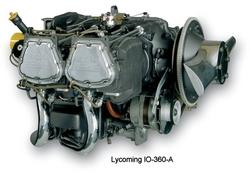"Several Conditions" Could Result In Loss Of Power
 The FAA has revised an SAIB (Special Airworthiness Information
Bulletin) concerning a condition on certain Lycoming four, six, and
eight cylinder reciprocating engines with a Teledyne Continental
Motors (TCM) (formerly Bendix) Series D2000 and D3000 Dual Magneto
(2 magnetos with a single drive). Several conditions identified
could result in separation of the magneto from the engine, which
will result in the loss of power. These engines can be identified
by the letter “D” in the 4th or 5th character in the
engine model’s suffix.
The FAA has revised an SAIB (Special Airworthiness Information
Bulletin) concerning a condition on certain Lycoming four, six, and
eight cylinder reciprocating engines with a Teledyne Continental
Motors (TCM) (formerly Bendix) Series D2000 and D3000 Dual Magneto
(2 magnetos with a single drive). Several conditions identified
could result in separation of the magneto from the engine, which
will result in the loss of power. These engines can be identified
by the letter “D” in the 4th or 5th character in the
engine model’s suffix.
The FAA says that most of the problems have occurred in Lycoming
IO-360-A1B6D and IO-360-A3B6D engines installed on Mooney M20J-201
and Cessna 177RG aircraft, although the potential for magneto
separation exists on any engine with a TCM Dual Magneto installed.
At this time, the airworthiness concern is not an unsafe condition
that would warrant the issuance of an AD.
For various reasons, several incidents of TCM Dual Magnetos
separating from Lycoming engines during flight have occurred. One
failure occurred on the first flight after installation of a newly
overhauled magneto. The failure occurred due to cracks in the
magneto housing mounting flange area that were present as a result
of the magneto’s prior operation. During the overhaul
process, the overhaul manual only required visual inspection of the
magneto.
Another failure mode has been due to the use of the wrong gasket
between the magneto and the engine accessory housing. Lycoming
Service Instruction (SI) 1508B clearly shows that the gasket must
be circular and no part of the gasket can extend beyond the flange
of the magneto housing. To be more specific, using a gasket with
extensions on the outside diameter that allows the stud from the
accessory housing to go through the gasket, and position the gasket
between the magneto clamp and the accessory housing, is
unacceptable.
 When a gasket is located between the magneto clamp and
accessory housing it will compress and in time result in a loose
magneto. A loose magneto will result in the magneto clamp wearing
into the magneto mounting flange. Ultimately, the flange thickness
will be reduced and the flange will fail.
When a gasket is located between the magneto clamp and
accessory housing it will compress and in time result in a loose
magneto. A loose magneto will result in the magneto clamp wearing
into the magneto mounting flange. Ultimately, the flange thickness
will be reduced and the flange will fail.
The FAA indicates that improper maintenance usually occurs when
magneto maintenance is performed in the field and the nuts holding
the magneto clamps in position are removed or loosened. When these
nuts are reinstalled, new lock washers must be used because they
lose their locking ability with repetitive usage. The ability to
obtain the proper torque on the nuts securing the magneto clamps or
even make them adequately tight depends on the accessibility of the
nuts when the engine is installed in the airplane. Magnetos are
more accessible on some airplanes than on others and
obtaining the correct torque is easier. However, on some
installations, the working room is limited and the magneto clamping
nuts are inaccessible making proper torquing difficult. As stated
above, most of the problems have occurred on Lycoming IO-360-A1B6D
and IO-360-A3B6D engines installed in
Mooney M20J-201 and Cessna 177RG aircraft because of
inaccessibility of the nuts securing the magneto clamps.
The only change in the previous SAIB is that the FAA now
recommends that pilots and owners ensure that the facility
overhauling magnetos on these engines has inspected, or will
inspect, the magneto housing for cracks by using a form of
nondestructive test (NDT). There are no NDT instructions in
the current TCM Magneto Overhaul Manual. A documented procedure
using a Level III fluorescent penetrant material, as specified in
either current version of SAE International Standards Document SAE
2647 or ASTM International Standards Document ASTM 1417, is
acceptable. A procedure recommended by TCM is also acceptable. A
Qualified Inspector, as specified in FAA Advisory Circular 43-13 or
MIL Standard 410, is to perform the fluorescent-penetrant
inspection. A qualified FAA Airframe and Powerplant Mechanic may
also perform the fluorescent-penetrant inspection.
 ANN's Daily Aero-Linx (04.13.24)
ANN's Daily Aero-Linx (04.13.24) ANN's Daily Aero-Term (04.13.24): Beyond Visual Line Of Sight (BVLOS)
ANN's Daily Aero-Term (04.13.24): Beyond Visual Line Of Sight (BVLOS) Airborne 04.09.24: SnF24!, Piper-DeltaHawk!, Fisher Update, Junkers
Airborne 04.09.24: SnF24!, Piper-DeltaHawk!, Fisher Update, Junkers Aero-News: Quote of the Day (04.14.24)
Aero-News: Quote of the Day (04.14.24) ANN's Daily Aero-Term (04.14.24): Maximum Authorized Altitude
ANN's Daily Aero-Term (04.14.24): Maximum Authorized Altitude




